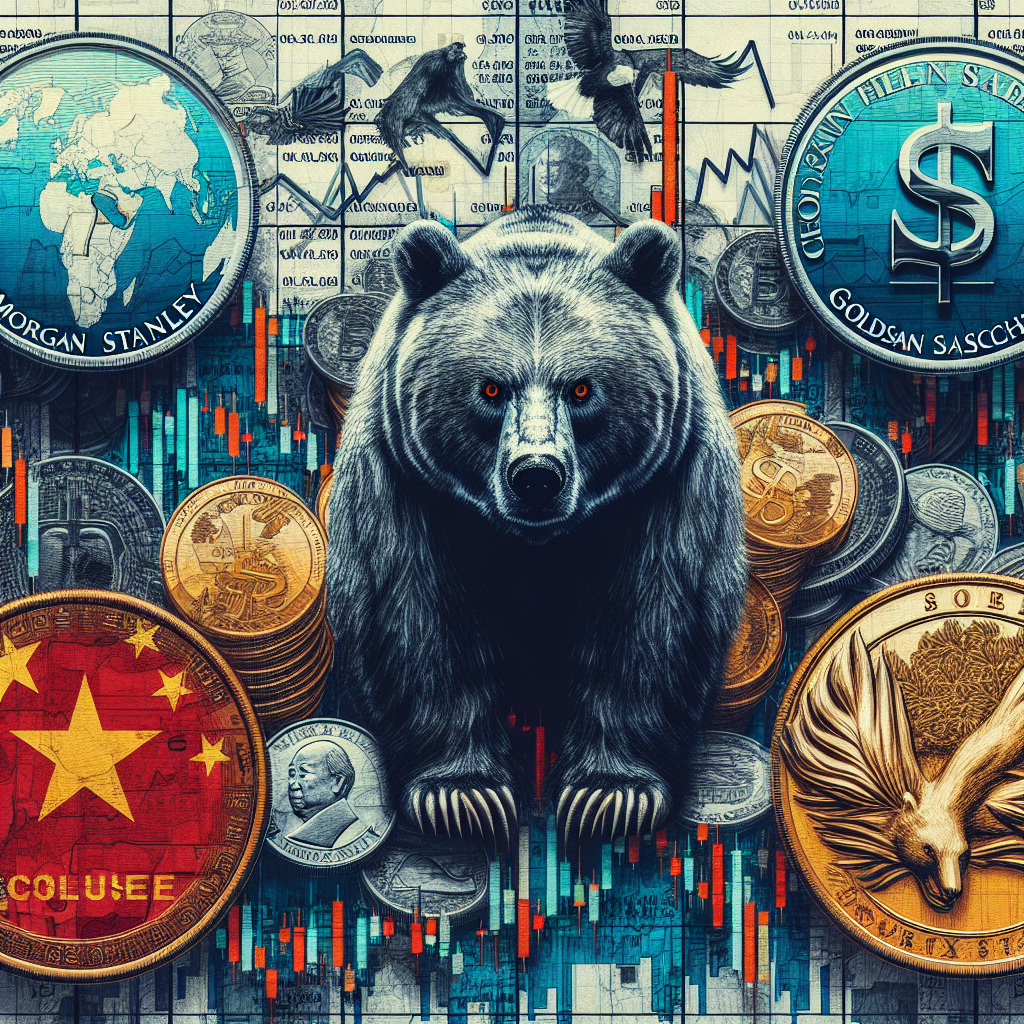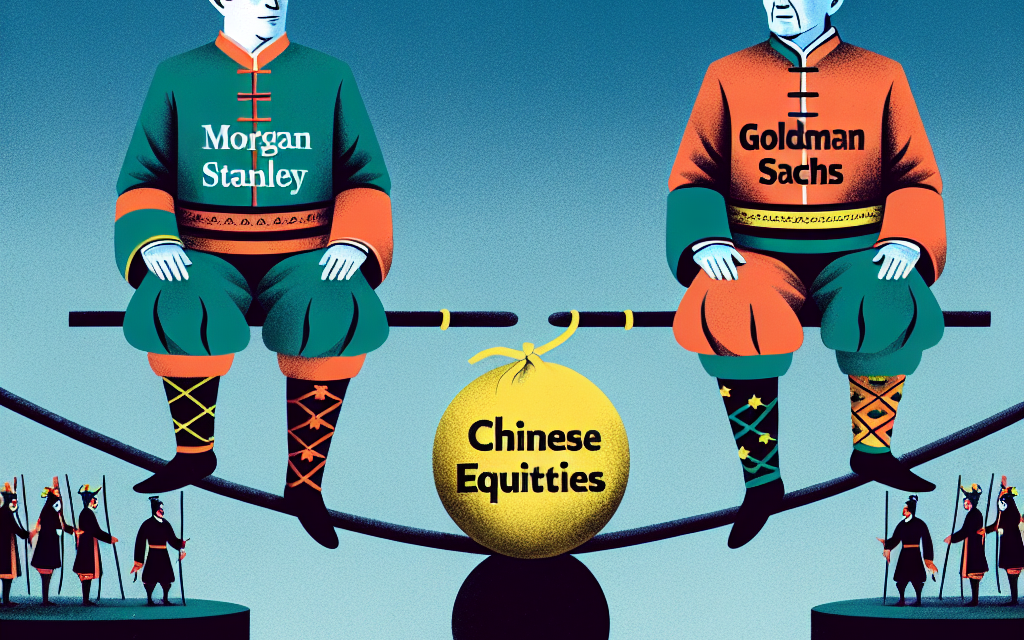“Navigating Uncertainty: Morgan Stanley and Goldman Sachs Tread Carefully in China’s Market Waters”
Introduction
Morgan Stanley and Goldman Sachs, two of the world’s leading investment banks, have recently adopted a cautious stance on Chinese equities, reflecting growing concerns over the economic and regulatory landscape in China. This shift comes amid a backdrop of heightened market volatility and uncertainty, driven by a series of regulatory crackdowns by Chinese authorities on key sectors such as technology, education, and real estate. Both financial giants have adjusted their investment strategies, advising clients to exercise prudence when considering exposure to Chinese markets. This cautious approach underscores the complexities and risks associated with investing in China, as the country navigates its economic policies and regulatory reforms.
Impact Of Cautious Stance On Chinese Equities By Morgan Stanley And Goldman Sachs
In recent months, the financial world has been closely observing the cautious stance adopted by Morgan Stanley and Goldman Sachs regarding Chinese equities. This shift in strategy by two of the most influential investment banks has significant implications for global investors and the broader market. As these financial giants reassess their positions, it is essential to understand the underlying reasons for their caution and the potential impact on Chinese equities.
To begin with, the cautious approach by Morgan Stanley and Goldman Sachs can be attributed to several factors, including regulatory uncertainties and economic challenges within China. Over the past year, the Chinese government has implemented a series of regulatory crackdowns across various sectors, including technology, education, and real estate. These measures, aimed at addressing issues such as data privacy, anti-competitive practices, and financial stability, have created an environment of uncertainty for investors. Consequently, Morgan Stanley and Goldman Sachs have become more circumspect in their outlook, as they navigate the complexities of these regulatory changes.
Moreover, China’s economic landscape has been facing headwinds, further contributing to the cautious sentiment. The country’s growth has been slowing, partly due to the lingering effects of the COVID-19 pandemic and supply chain disruptions. Additionally, the real estate sector, a significant driver of China’s economy, has been under pressure due to the financial troubles of major property developers. These economic challenges have prompted Morgan Stanley and Goldman Sachs to reassess their exposure to Chinese equities, as they weigh the risks and opportunities in this evolving market.
As these investment banks adopt a more cautious stance, the impact on Chinese equities is becoming increasingly evident. For one, investor sentiment has been affected, leading to increased volatility in the market. The cautious outlook from such prominent financial institutions can influence other investors, who may follow suit and reduce their exposure to Chinese stocks. This, in turn, can lead to downward pressure on stock prices, as demand for these equities diminishes.
Furthermore, the cautious approach by Morgan Stanley and Goldman Sachs may also affect the flow of foreign capital into China. As these banks adjust their investment strategies, other institutional investors may become more hesitant to allocate funds to Chinese equities. This potential reduction in foreign investment could have broader implications for China’s capital markets, as it may limit the availability of funding for Chinese companies seeking to expand and innovate.
However, it is important to note that the cautious stance does not necessarily imply a complete withdrawal from Chinese equities. Both Morgan Stanley and Goldman Sachs continue to recognize the long-term potential of China’s market, given its size and growth prospects. Instead, their approach reflects a more selective and strategic allocation of resources, as they seek to balance risk and reward in an uncertain environment.
In conclusion, the cautious stance on Chinese equities by Morgan Stanley and Goldman Sachs underscores the complexities and challenges facing investors in this market. While regulatory uncertainties and economic headwinds have prompted a reevaluation of their strategies, the long-term potential of China’s market remains a key consideration. As global investors navigate this evolving landscape, the actions of these influential banks will continue to play a crucial role in shaping the outlook for Chinese equities.
Reasons Behind Morgan Stanley And Goldman Sachs’ Cautious Approach To Chinese Markets
In recent months, Morgan Stanley and Goldman Sachs, two of the most influential financial institutions globally, have adopted a cautious stance on Chinese equities. This shift in strategy reflects a broader sentiment among international investors who are increasingly wary of the risks associated with the Chinese market. Several factors contribute to this cautious approach, each interwoven with the complexities of China’s economic and regulatory landscape.
To begin with, China’s economic growth has shown signs of deceleration, prompting concerns about the sustainability of its long-term expansion. The Chinese government has set ambitious targets for economic growth, yet recent data suggests that achieving these goals may be challenging. Slower growth can be attributed to a variety of factors, including a maturing economy, demographic shifts, and the lingering effects of the COVID-19 pandemic. As a result, investors are becoming more circumspect, recognizing that the once seemingly unstoppable engine of growth may be losing some of its momentum.
Moreover, regulatory crackdowns in China have introduced a layer of uncertainty that has further dampened investor enthusiasm. Over the past year, the Chinese government has implemented a series of stringent regulations targeting key sectors such as technology, education, and real estate. These measures, aimed at addressing issues like data privacy, monopolistic practices, and social inequality, have had significant repercussions on market valuations. For instance, the technology sector, once a darling of investors, has experienced substantial volatility as companies grapple with new compliance requirements. Consequently, Morgan Stanley and Goldman Sachs are exercising caution, mindful of the potential for further regulatory interventions that could impact their investment portfolios.
In addition to domestic factors, geopolitical tensions have also played a role in shaping the cautious approach of these financial giants. The relationship between China and the United States, in particular, remains fraught with challenges. Trade disputes, human rights concerns, and issues related to Taiwan and Hong Kong have all contributed to an atmosphere of uncertainty. This geopolitical backdrop has heightened the risk perception associated with Chinese equities, prompting investors to reassess their exposure to the market. Morgan Stanley and Goldman Sachs, with their global reach and influence, are acutely aware of these dynamics and are adjusting their strategies accordingly.
Furthermore, currency fluctuations and capital flow restrictions have added another layer of complexity to investing in Chinese markets. The Chinese yuan’s value can be influenced by a range of factors, including government policy and global economic conditions. For international investors, currency risk is a critical consideration, as it can significantly impact returns. Additionally, China’s capital controls, designed to manage the flow of money in and out of the country, can pose challenges for investors seeking liquidity and flexibility. These factors contribute to the cautious stance adopted by Morgan Stanley and Goldman Sachs, as they navigate the intricacies of the Chinese financial system.
In conclusion, the cautious approach of Morgan Stanley and Goldman Sachs towards Chinese equities is a reflection of a confluence of factors, including slowing economic growth, regulatory uncertainties, geopolitical tensions, and currency risks. As these financial institutions continue to monitor developments in China, their strategies will likely evolve in response to the ever-changing landscape. For now, their prudence underscores the complexities and challenges inherent in investing in one of the world’s most dynamic yet unpredictable markets.
How Morgan Stanley And Goldman Sachs’ Views Affect Global Investment Strategies
In recent months, Morgan Stanley and Goldman Sachs, two of the most influential financial institutions in the world, have adopted a cautious stance on Chinese equities. This shift in perspective is not only significant for investors with direct exposure to China but also has broader implications for global investment strategies. As these financial giants reassess their positions, it is essential to understand the underlying reasons for their caution and how it might influence global markets.
To begin with, the cautious approach taken by Morgan Stanley and Goldman Sachs is largely driven by a combination of economic, regulatory, and geopolitical factors. China’s economic growth, which has been a major driver of global economic expansion over the past few decades, is showing signs of slowing. The Chinese government’s efforts to transition from an investment-driven economy to one that is more consumption-oriented have introduced new challenges. Additionally, the ongoing regulatory crackdown on various sectors, including technology and real estate, has created an environment of uncertainty that has made investors wary.
Moreover, geopolitical tensions, particularly between China and the United States, have further complicated the investment landscape. Trade disputes, technological competition, and differing political ideologies have all contributed to a more volatile environment. As a result, Morgan Stanley and Goldman Sachs have become more circumspect in their outlook on Chinese equities, advising clients to exercise caution and consider the potential risks involved.
This cautious stance has significant implications for global investment strategies. For one, it signals a potential shift in capital flows. Investors who might have previously allocated a substantial portion of their portfolios to Chinese equities may now look to diversify their investments across other emerging markets or developed economies. This reallocation of capital could lead to increased volatility in global markets as investors seek new opportunities and adjust their risk profiles.
Furthermore, the views of Morgan Stanley and Goldman Sachs could influence other institutional investors and asset managers. Given their stature and influence in the financial world, their cautious outlook may prompt other market participants to reevaluate their own positions on Chinese equities. This collective reassessment could lead to a broader rebalancing of global investment portfolios, with potential ripple effects across various asset classes.
In addition to influencing capital flows, the cautious stance on Chinese equities may also impact investor sentiment. As these financial institutions express concerns about the Chinese market, it could lead to a more risk-averse attitude among investors. This shift in sentiment might result in increased demand for safer assets, such as government bonds or blue-chip stocks, as investors seek to protect their portfolios from potential downturns.
In conclusion, the cautious stance adopted by Morgan Stanley and Goldman Sachs on Chinese equities is a reflection of the complex and evolving landscape in China. While the immediate impact may be felt most acutely by those with direct exposure to Chinese markets, the broader implications for global investment strategies are significant. As investors navigate this uncertain environment, they must remain vigilant and adaptable, considering both the risks and opportunities that arise. Ultimately, the views of these financial giants serve as a reminder of the interconnectedness of global markets and the importance of a well-considered investment strategy in an ever-changing world.
Historical Analysis Of Morgan Stanley And Goldman Sachs’ Positions On Chinese Equities

Morgan Stanley and Goldman Sachs, two of the most influential financial institutions in the world, have long been regarded as barometers for global investment trends. Their positions on Chinese equities have historically been a subject of keen interest for investors and analysts alike. Over the years, both firms have navigated the complexities of the Chinese market with a blend of optimism and caution, reflecting the evolving economic landscape and geopolitical dynamics.
In the early 2000s, as China began to open its markets and integrate more deeply into the global economy, both Morgan Stanley and Goldman Sachs were among the first to recognize the potential of Chinese equities. They were instrumental in channeling foreign investments into China, capitalizing on the country’s rapid economic growth and industrial expansion. During this period, their strategies were largely characterized by bullish outlooks, driven by China’s impressive GDP growth rates and the burgeoning middle class that promised to fuel domestic consumption.
However, as the Chinese market matured, so did the strategies of these financial giants. The 2008 global financial crisis marked a turning point, prompting a more cautious approach. The crisis underscored the interconnectedness of global markets and highlighted the risks associated with overexposure to any single economy, including China. In response, Morgan Stanley and Goldman Sachs began to advocate for a more balanced portfolio, emphasizing the importance of diversification to mitigate potential risks.
As the 2010s progressed, the Chinese market faced new challenges, including regulatory changes, trade tensions with the United States, and concerns over corporate governance. These factors contributed to increased volatility in Chinese equities, prompting both firms to reassess their positions. Morgan Stanley, for instance, began to emphasize the importance of understanding the regulatory environment and its implications for specific sectors. Similarly, Goldman Sachs highlighted the need for investors to be discerning, focusing on companies with strong fundamentals and transparent governance practices.
The cautious stance adopted by Morgan Stanley and Goldman Sachs in recent years can also be attributed to China’s shifting economic priorities. The Chinese government’s focus on transitioning from an export-driven economy to one centered on domestic consumption and technological innovation has created both opportunities and uncertainties. While sectors such as technology and consumer goods have shown promise, others, particularly those reliant on traditional manufacturing, have faced headwinds.
Moreover, geopolitical tensions have further complicated the investment landscape. The ongoing trade disputes between China and the United States, coupled with concerns over data security and intellectual property rights, have added layers of complexity to investment decisions. In this context, both Morgan Stanley and Goldman Sachs have underscored the importance of a nuanced understanding of geopolitical risks and their potential impact on Chinese equities.
In conclusion, the historical analysis of Morgan Stanley and Goldman Sachs’ positions on Chinese equities reveals a trajectory marked by initial enthusiasm, tempered by a growing awareness of the inherent risks and complexities. Their cautious stance today reflects a deep understanding of the multifaceted nature of the Chinese market, shaped by economic, regulatory, and geopolitical factors. As they continue to navigate this dynamic landscape, their insights and strategies will undoubtedly remain influential, guiding investors in making informed decisions about their exposure to Chinese equities.
Comparing Morgan Stanley And Goldman Sachs’ Strategies In Emerging Markets
In recent months, both Morgan Stanley and Goldman Sachs have exhibited a cautious stance towards Chinese equities, reflecting broader concerns about the economic and regulatory landscape in China. This approach is particularly noteworthy given the historical enthusiasm these financial giants have shown for emerging markets, where they have often sought high returns despite inherent risks. The shift in strategy underscores a nuanced understanding of the current challenges and opportunities within the Chinese market, as well as a broader recalibration of their emerging markets strategies.
Morgan Stanley, known for its analytical rigor and strategic foresight, has been particularly vocal about the potential risks associated with Chinese equities. The firm has highlighted several factors contributing to its cautious outlook, including regulatory crackdowns on key sectors such as technology and education, which have introduced significant volatility and uncertainty. Furthermore, concerns about China’s real estate market, particularly the financial stability of major developers, have added another layer of complexity. These issues, coupled with geopolitical tensions and the ongoing impact of the COVID-19 pandemic, have led Morgan Stanley to adopt a more conservative approach, advising clients to be selective and strategic in their investments.
Similarly, Goldman Sachs has also expressed reservations about the Chinese market, albeit with a slightly different emphasis. While acknowledging the regulatory and economic challenges, Goldman Sachs has focused on the potential for long-term growth and the importance of understanding China’s evolving policy landscape. The firm has emphasized the need for investors to be agile and informed, suggesting that opportunities still exist for those willing to navigate the complexities of the market. This perspective aligns with Goldman Sachs’ broader strategy in emerging markets, where it seeks to balance risk and reward by leveraging its deep market insights and global reach.
Despite their cautious stance, both Morgan Stanley and Goldman Sachs recognize the significance of China as a key player in the global economy. They acknowledge that China’s economic transformation and its role in global supply chains cannot be ignored. Consequently, both firms continue to monitor developments closely, ready to adjust their strategies as conditions evolve. This approach reflects a broader trend among global financial institutions, which are increasingly adopting a more dynamic and responsive strategy in emerging markets, recognizing that flexibility and adaptability are crucial in navigating the complexities of these regions.
Moreover, the cautious approach of Morgan Stanley and Goldman Sachs towards Chinese equities is indicative of a broader recalibration of their emerging markets strategies. Both firms are increasingly focusing on diversification, seeking opportunities in other regions that may offer more stable growth prospects. This includes exploring markets in Southeast Asia, India, and Latin America, where economic reforms and demographic trends present attractive investment opportunities. By diversifying their portfolios, these financial giants aim to mitigate risks and enhance returns, ensuring that they remain well-positioned to capitalize on emerging market growth.
In conclusion, the cautious stance adopted by Morgan Stanley and Goldman Sachs towards Chinese equities highlights the complexities and challenges of investing in emerging markets. While both firms recognize the potential risks, they also remain attuned to the opportunities that these markets present. By adopting a strategic and informed approach, they aim to navigate the uncertainties of the current landscape, ensuring that they continue to deliver value to their clients while maintaining their leadership in the global financial arena. As the situation in China and other emerging markets continues to evolve, the strategies of these financial powerhouses will undoubtedly adapt, reflecting their commitment to prudent and forward-thinking investment practices.
Investor Reactions To Morgan Stanley And Goldman Sachs’ Cautious Outlook On China
In recent months, the financial world has been closely monitoring the evolving stance of major investment banks on Chinese equities. Notably, Morgan Stanley and Goldman Sachs, two of the most influential players in the global financial markets, have adopted a cautious outlook on Chinese stocks. This shift in perspective has sparked a range of reactions among investors, who are now reevaluating their strategies in light of these developments. As these investment giants adjust their positions, it is essential to understand the underlying reasons for their caution and the potential implications for global investors.
Morgan Stanley and Goldman Sachs have long been regarded as barometers of market sentiment, and their views on Chinese equities carry significant weight. The cautious stance adopted by these banks is primarily driven by a confluence of factors that have raised concerns about the stability and growth prospects of China’s economy. Among these factors, regulatory crackdowns on key sectors, such as technology and real estate, have created an environment of uncertainty. The Chinese government’s increased scrutiny and intervention in these industries have led to heightened volatility, prompting investors to reassess the risk-reward balance of their portfolios.
Moreover, the ongoing geopolitical tensions between China and other major economies, particularly the United States, have further complicated the investment landscape. Trade disputes, coupled with concerns over supply chain disruptions, have added layers of complexity to the decision-making process for investors. In this context, Morgan Stanley and Goldman Sachs’ cautious outlook can be seen as a prudent response to the potential risks associated with these geopolitical dynamics.
In addition to regulatory and geopolitical factors, macroeconomic indicators have also played a role in shaping the cautious stance of these investment banks. China’s economic growth has shown signs of slowing, with recent data pointing to a deceleration in key sectors such as manufacturing and consumer spending. This slowdown has raised questions about the sustainability of China’s growth trajectory, prompting investors to adopt a more conservative approach.
As Morgan Stanley and Goldman Sachs signal their caution, investors are faced with the challenge of navigating an increasingly complex market environment. Some investors may choose to follow the lead of these financial giants, reducing their exposure to Chinese equities in favor of more stable markets. Others, however, may view the current situation as an opportunity to capitalize on potential undervaluation, betting on a rebound in Chinese stocks once the regulatory and economic uncertainties subside.
The reactions among investors are varied, reflecting differing risk appetites and investment strategies. For those with a long-term perspective, the current caution may be seen as a temporary phase, with the potential for future growth in China’s dynamic economy. Conversely, short-term investors may prioritize risk mitigation, opting to diversify their portfolios to minimize exposure to potential downturns.
In conclusion, the cautious stance adopted by Morgan Stanley and Goldman Sachs on Chinese equities underscores the complexities and uncertainties facing global investors. As these investment banks adjust their outlooks, investors are compelled to reassess their strategies, balancing the potential risks and rewards associated with Chinese markets. While the future remains uncertain, the evolving landscape presents both challenges and opportunities for those willing to navigate the intricacies of investing in China. As the situation continues to unfold, investors will need to remain vigilant, adapting their approaches to align with the shifting dynamics of the global economy.
Future Implications Of Morgan Stanley And Goldman Sachs’ Stance On Chinese Equities
In recent months, Morgan Stanley and Goldman Sachs, two of the most influential financial institutions globally, have adopted a cautious stance on Chinese equities. This shift in strategy comes amid a complex interplay of economic, regulatory, and geopolitical factors that have cast a shadow over China’s financial markets. As these investment giants recalibrate their approach, the implications for global investors and the broader financial landscape are profound.
To begin with, the cautious stance of Morgan Stanley and Goldman Sachs reflects growing concerns about China’s economic trajectory. The Chinese economy, once a powerhouse of growth, has shown signs of slowing down. Factors such as a cooling property market, regulatory crackdowns on key sectors like technology and education, and ongoing trade tensions with the United States have contributed to a more uncertain economic outlook. Consequently, these financial institutions are reassessing the risk-reward balance of investing in Chinese equities, which have traditionally been seen as a high-growth opportunity.
Moreover, the regulatory environment in China has become increasingly unpredictable. Over the past year, the Chinese government has implemented a series of sweeping reforms aimed at curbing monopolistic practices, enhancing data security, and promoting social equity. While these measures align with the government’s long-term vision for sustainable development, they have also introduced significant volatility into the market. For instance, the abrupt regulatory changes in the technology sector led to sharp declines in the stock prices of major Chinese tech companies. This unpredictability has prompted Morgan Stanley and Goldman Sachs to exercise greater caution, as they seek to protect their clients’ investments from sudden market disruptions.
In addition to economic and regulatory factors, geopolitical tensions have also played a role in shaping the cautious approach of these financial institutions. The ongoing rivalry between the United States and China has created an environment of uncertainty, with potential implications for trade, technology, and investment flows. The imposition of tariffs, restrictions on technology transfers, and concerns over human rights issues have all contributed to a more complex geopolitical landscape. As a result, Morgan Stanley and Goldman Sachs are carefully evaluating the potential risks associated with Chinese equities, mindful of the broader geopolitical context.
The implications of this cautious stance are far-reaching. For global investors, the recalibration by Morgan Stanley and Goldman Sachs serves as a signal to reassess their own exposure to Chinese equities. While China remains an important market with significant growth potential, the heightened risks necessitate a more nuanced investment strategy. Investors may need to diversify their portfolios, consider alternative markets, or adopt a more selective approach to Chinese equities, focusing on sectors that are less susceptible to regulatory and geopolitical pressures.
Furthermore, the cautious approach of these financial institutions could influence other market participants. As leading players in the global financial system, Morgan Stanley and Goldman Sachs often set trends that others follow. Their stance on Chinese equities may prompt other investment firms to reevaluate their strategies, potentially leading to a broader shift in market sentiment. This, in turn, could impact capital flows into China, affecting the country’s ability to attract foreign investment and sustain its economic growth.
In conclusion, the cautious stance adopted by Morgan Stanley and Goldman Sachs on Chinese equities underscores the complex and evolving nature of the global financial landscape. As these institutions navigate the challenges posed by economic, regulatory, and geopolitical factors, their approach will have significant implications for investors and markets worldwide. By carefully considering these dynamics, investors can better position themselves to navigate the uncertainties and opportunities that lie ahead.
Q&A
1. **Why are Morgan Stanley and Goldman Sachs cautious about Chinese equities?**
Concerns over China’s economic slowdown, regulatory crackdowns, and geopolitical tensions have led to a cautious stance.
2. **What specific economic factors are influencing their caution?**
Slower GDP growth, property market instability, and weak consumer demand are key economic factors.
3. **How have regulatory changes in China impacted their outlook?**
Regulatory crackdowns on technology and education sectors have increased uncertainty and risk.
4. **What geopolitical issues are affecting their stance on Chinese equities?**
Tensions between China and the U.S., including trade disputes and technology restrictions, are significant concerns.
5. **Have Morgan Stanley and Goldman Sachs made any changes to their investment strategies in China?**
They have reduced exposure to certain sectors and are more selective in their investments.
6. **What sectors in China are they particularly cautious about?**
Technology, real estate, and education sectors are viewed with increased caution due to regulatory and economic challenges.
7. **Are there any sectors in China that they still find attractive?**
Some sectors like renewable energy and consumer staples may still be considered attractive due to long-term growth potential.
Conclusion
Morgan Stanley and Goldman Sachs have adopted a cautious stance on Chinese equities due to a combination of factors including regulatory uncertainties, geopolitical tensions, and concerns over China’s economic growth trajectory. Both firms have highlighted the potential risks associated with investing in Chinese markets, advising investors to be selective and vigilant. This cautious approach reflects broader market apprehensions about China’s regulatory environment and its impact on corporate earnings and investor confidence. As a result, both Morgan Stanley and Goldman Sachs are recommending a more conservative investment strategy in Chinese equities, emphasizing the importance of risk management and careful stock selection in navigating the complex and evolving landscape of China’s financial markets.





